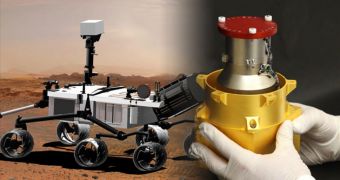For the first time in space exploration, a rover bound for the Red Planet will deliver a radiation detector on the surface of Mars. This will allow experts to determine whether the radiations prospective human astronauts there will be subjected to are harmful or not.
The instrument will fly to our neighboring planet aboard the Mars Science Laboratory (MSL) mission, which is now called Curiosity. The rover weighs about a ton, and is the size of a Mini Cooper.
It is scheduled to land on its target no earlier than August 2012, after a late 2011 launch. The machine will carry an impressive suite of scientific instruments, including the Radiation Assessment Detector.
RAD will be the first instrument of its kind to fly to Mars, but it will not begin its mission after touch down. Rather, it will be turned on about eight months earlier, as the MSL is traveling from Earth to its destination.
As such, the detector will take a variety of readings throughout space, which will allow mission planners at space agencies to make more informed decisions about sending people to space.
At this point, astronaut health concerns and lack if funding are the only things preventing us from putting space explorers on the Red Planet. A large-scale experiment, called Mars500, is already underway in Moscow to test the impact of long-term space flight on humans.
Those data will be combined with others obtained from different types of study, to paint a clearer picture of the danger a Mart-bound trip implies. The readings that RAD will produce will add to that puzzle, experts believe.
What NASA hopes to achieve by deploying it is a precise knowledge of the level of radiation that could harm astronauts. This would help experts in designing the most effective radiation shields possible.
“No one has fully characterized the radiation environment on the surface of another planet. If we want to send humans there, we need to do that,” explains Don Hassler, the principal investigator of RAD.
He holds an appointment at the Boulder, Colorado-based Southwest Research Institute (SwRI).
“The measurements we get during the cruise from Earth to Mars will help map the distribution of radiation throughout the solar system and be useful in mission design for wherever we send astronauts,” the expert goes on to say.
According to its chart, RAD will be capable of measuring both atomic and sub-atomic particles, as high levels of energy. These particles could easily harm DNA, and destroy even the most basic microbes.
“The primary science goal of Curiosity is to determine whether its landing site is, or ever was, a habitable environment, a place friendly to life,” explains expert Ashwin Vasavada.
“That involves looking both for conditions that would support life as well as for those that would be hazardous to life or its chemical predecessors,” he adds.
“Natural, high-energy radiation is just such a hazard, and RAD will give us the first look at the present level of this radiation and help us to better estimate radiation levels throughout Mars' history,” Vasavada adds.
The expert is based at the NASA Jet Propulsion Laboratory (JPL), in Pasadena, California, where he holds an appointment as a MSL deputy project scientist.

 14 DAY TRIAL //
14 DAY TRIAL //